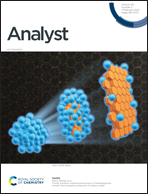A novel colorimetric and far-red emission ratiometric fluorescent probe for the highly selective and ultrafast detection of hypochlorite in water and its application in bioimaging†
Abstract
Hypochlorous acid (HOCl)/hypochlorite (OCl−), an important reactive oxygen species, plays a number of important roles in various physiological processes. However, abnormal levels of OCl− can cause many serious diseases, such as atherosclerosis, rheumatoid arthritis, cardiovascular disease, and cancer. The development of efficient methods to monitor OCl− in biological systems is therefore of particular importance. Thus, we herein report a novel isophorone-based fluorescent probe, i.e., DCOH-FR-OCl, for OCl− detection. This probe was found to exhibit colorimetric and far-red ratiometric fluorescence response signals, excellent selectivity and sensitivity for OCl− (detection limit, 88.06 nM), a remarkably large Stokes shift (158 nm), an ultrafast response (completed within 3 s), perfect photostability, and good water solubility (100% in aqueous media). DCOH-FR-OCl, as we know, is the first probe that can detect OCl− by using two different response signals at an ultrafast speed with a large Stokes shift in fully aqueous media. Furthermore, DCOH-FR-OCl can be successfully employed in the real-time imaging of endogenous and exogenous OCl− in living cells.



 Please wait while we load your content...
Please wait while we load your content...